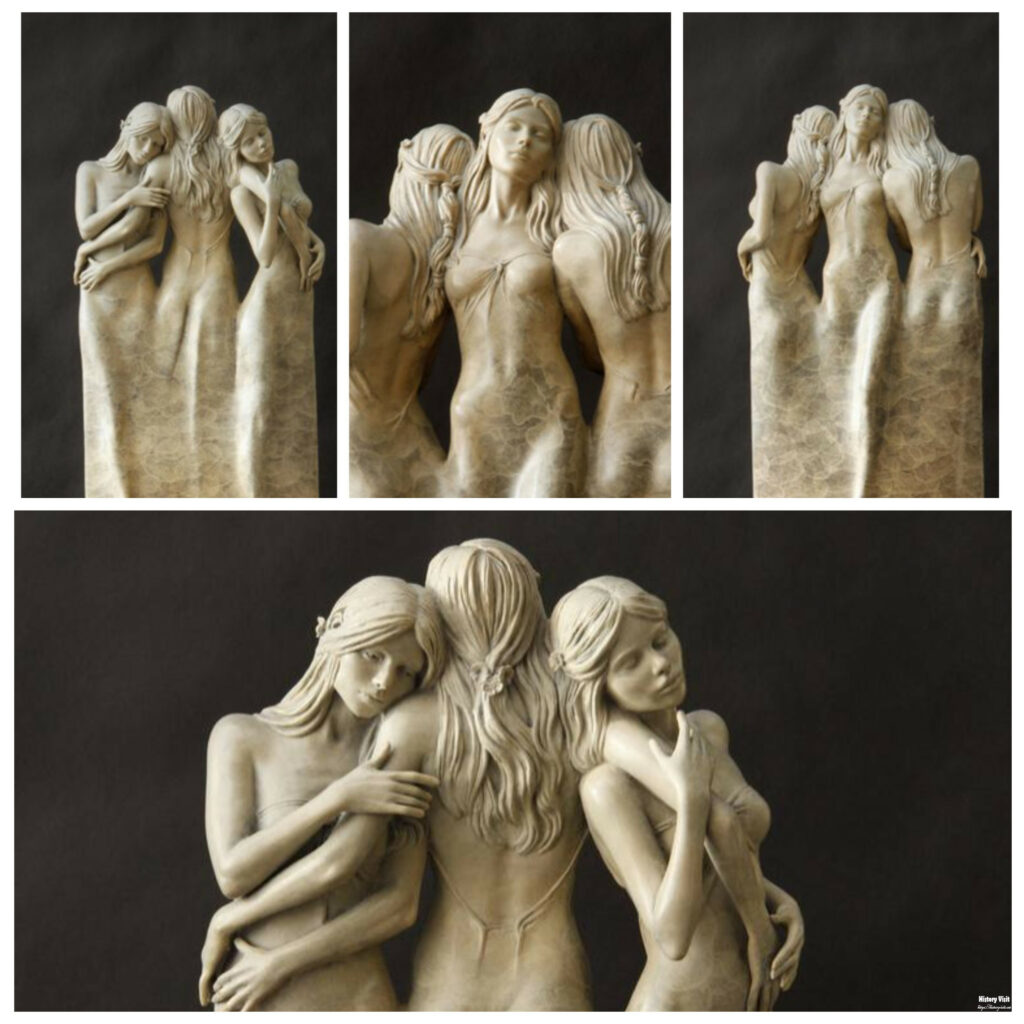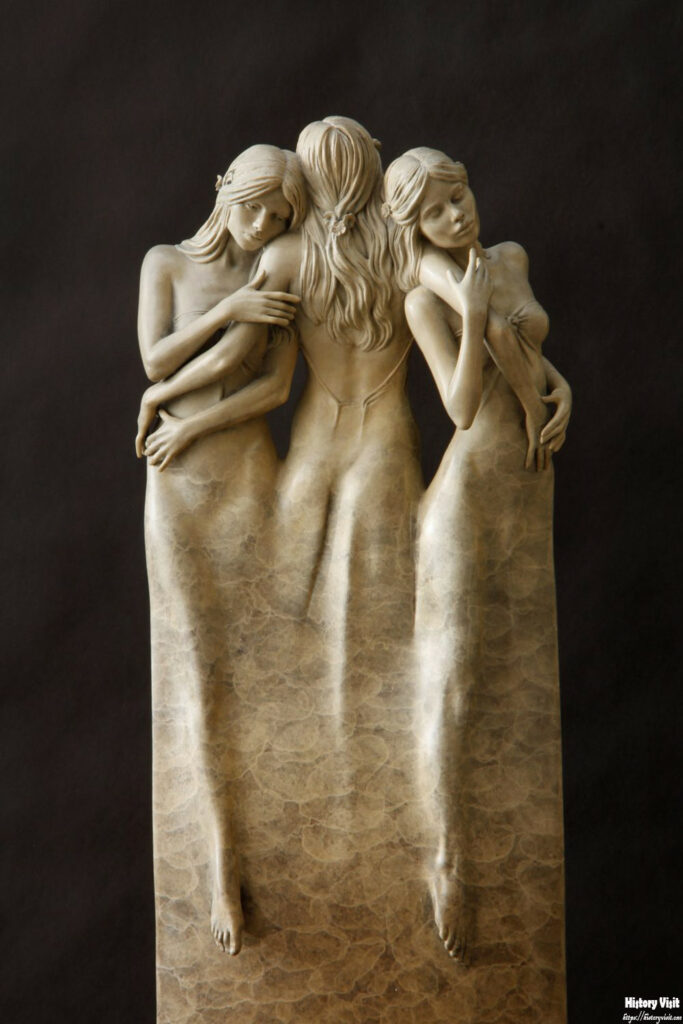The Three Graces (Table Top) by Michael James Talbot: A Modern Homage to Classical Elegance

Introduction
In the realm of contemporary sculpture, few artists have achieved the seamless blend of classical inspiration and modern execution as Michael James Talbot. Renowned for his meticulous craftsmanship and profound thematic exploration, Talbot has captivated audiences with his ability to breathe new life into timeless subjects. Among his most celebrated works is “The Three Graces (Table Top),” a sculpture that stands as a testament to his skill in merging historical elegance with contemporary artistic sensibilities.

“The Three Graces (Table Top)” reimagines the classical motif of the Three Graces—mythological figures representing Beauty, Mirth, and Good Cheer—within a modern context. Talbot’s interpretation not only honors the rich artistic tradition surrounding these figures but also infuses them with a fresh perspective that resonates with today’s viewers. This sculpture, designed for intimate display, invites a closer, more personal engagement, allowing admirers to connect deeply with its intricate details and underlying themes. Through this work, Talbot bridges the gap between past and present, creating a piece that is both a homage to classical beauty and a statement of contemporary artistic vision.
Reimagining Classical Beauty

“The Three Graces” is a motif deeply rooted in classical art and mythology. Traditionally, these figures represent the daughters of Zeus—Aglaia (Beauty), Euphrosyne (Mirth), and Thalia (Good Cheer). Throughout history, they have been depicted by various artists, symbolizing different aspects of beauty and human experience. From the ancient sculptures of Greece and Rome to the Renaissance paintings of Botticelli and Raphael, the Three Graces have remained a popular subject, embodying ideals of harmony, grace, and elegance.
Michael James Talbot’s interpretation of this timeless theme is a testament to his skill in revitalizing classical subjects for contemporary audiences. In “The Three Graces (Table Top),” Talbot reimagines these mythological figures with a fresh perspective, infusing them with a modern sensibility while retaining their classical roots. Each figure is sculpted with a blend of realism and stylization, capturing not only their physical beauty but also the essence of their mythical personas. This approach allows the viewer to appreciate the timelessness of the Graces while engaging with them in a new and relevant context.

Talbot’s sculpture stands out because of its intimate scale, designed to be displayed on a table top. This format invites a closer, more personal interaction with the piece, contrasting with the grandiose depictions often found in historical artworks. By presenting the Graces in this manner, Talbot creates a sense of immediacy and accessibility, allowing viewers to form a more intimate connection with the figures. This personal engagement enhances the viewer’s appreciation of the sculpture’s detailed craftsmanship and the subtle expressions of each Grace.
In “The Three Graces (Table Top),” Talbot successfully bridges the gap between ancient myth and modern art. His work serves as a reminder of the enduring relevance of classical themes, demonstrating how they can be adapted and reinterpreted to resonate with contemporary audiences. By drawing on the rich history of the Three Graces and infusing it with his unique artistic vision, Talbot has created a piece that is both a homage to the past and a statement of present-day artistic innovation.
Artistic Technique and Materiality

Michael James Talbot is known for his meticulous approach to sculpture, often working with bronze to achieve a finish that combines durability with aesthetic warmth. Bronze has been a preferred medium for sculptors throughout history due to its versatility and longevity. Talbot’s use of bronze in “The Three Graces (Table Top)” not only connects his work to this rich tradition but also allows him to explore the medium’s full potential in terms of texture and detail.
In this sculpture, Talbot employs the lost-wax casting technique, an ancient method that remains unparalleled in its ability to capture fine details. This technique involves creating a wax model of the sculpture, which is then covered in a ceramic shell. Once the shell hardens, the wax is melted away, leaving a cavity into which molten bronze is poured. The result is a highly detailed and durable bronze sculpture that faithfully reproduces the intricacies of the original wax model. This method allows Talbot to achieve the delicate drapery and lifelike anatomy that characterize his work.

The sculpture showcases Talbot’s mastery in manipulating bronze to create flowing drapery and lifelike anatomy. Each Grace is adorned with delicate garments that appear to ripple in an unseen breeze, a testament to Talbot’s ability to convey movement and life within a static medium. The careful attention to the folds and textures of the fabric enhances the realism of the figures, making them appear almost ethereal. This level of detail requires not only technical skill but also a deep understanding of the human form and how it interacts with its environment.
The patina on the bronze adds a layer of depth, enhancing the play of light and shadow on the figures and imbuing them with a dynamic presence. Patination is a process in which the surface of the bronze is treated to develop a protective and aesthetically pleasing finish. Talbot’s choice of patina complements the sculpture’s overall composition, adding richness and complexity to the visual experience. The interplay of light and shadow on the patinated surface brings the figures to life, highlighting their graceful forms and intricate details.
Symbolism and Interpretation

At its core, “The Three Graces (Table Top)” is more than a display of technical prowess; it is a narrative piece that invites viewers to explore its deeper meanings. The Three Graces have always symbolized beauty, joy, and human connection, and Talbot’s interpretation continues this tradition while introducing new layers of meaning. By reimagining these figures in a contemporary context, Talbot invites viewers to reflect on how these ancient ideals remain relevant today.
Each Grace in Talbot’s sculpture embodies different aspects of their traditional symbolism. Aglaia, representing Beauty, is depicted with a serene and contemplative expression, suggesting an inner radiance that transcends physical appearance. Euphrosyne, symbolizing Mirth, is captured in a moment of light-heartedness, her playful pose and joyous demeanor conveying a sense of carefree happiness. Thalia, representing Good Cheer, exudes warmth and kindness, her open and welcoming gesture inviting viewers to share in her positive energy. Together, these figures create a harmonious composition that celebrates the interconnectedness of these ideals.

The sculpture can be seen as a celebration of human connection and the timeless nature of beauty. By bringing these figures into a modern context, Talbot bridges the past and present, inviting viewers to reflect on how these ancient ideals continue to shape our understanding of art and aesthetics. The intimate scale of the piece encourages a personal connection with the viewer, allowing them to appreciate the subtleties of each figure’s expression and posture. This interaction enhances the viewer’s experience, making the themes of the sculpture more immediate and relatable.
Talbot’s “The Three Graces (Table Top)” also serves as a commentary on the enduring power of classical themes in contemporary art. In an age where art is often driven by novelty and innovation, Talbot’s work reminds us of the timeless appeal of beauty, joy, and human connection. By reinterpreting these ancient symbols in a modern context, he demonstrates their continued relevance and ability to inspire. This fusion of classical and contemporary elements creates a piece that is both a tribute to the past and a reflection of present-day values.
Conclusion

Michael James Talbot’s “The Three Graces (Table Top)” stands as a remarkable fusion of classical elegance and contemporary artistry. Through his expert use of bronze and the intricate lost-wax casting technique, Talbot has created a sculpture that not only captures the timeless beauty of the mythological Graces but also brings them into a modern light. The intimate scale of the piece invites personal engagement, allowing viewers to appreciate the delicate details and the profound symbolism embedded in each figure. This personal interaction enhances the viewer’s experience, making the sculpture a reflective and emotional journey into themes of beauty, joy, and human connection.

Talbot’s work is a powerful reminder of the enduring relevance of classical themes in contemporary art. By reinterpreting the Three Graces with a modern sensibility, he bridges the gap between ancient mythology and present-day values, demonstrating the timeless appeal of these ideals. “The Three Graces (Table Top)” is not just a tribute to historical artistry but also a reflection of contemporary aesthetic and philosophical concerns. Through this piece, Talbot reaffirms the lasting impact of beauty, harmony, and joy, inviting us to rediscover these timeless virtues in our own lives. In doing so, he creates a lasting connection between the past and the present, showcasing the universal and eternal nature of art.


